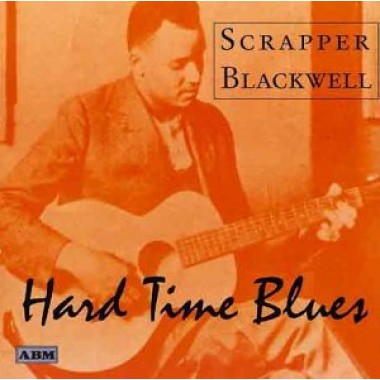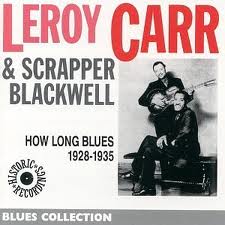Acoustic Blues Guitar Video Lesson Preview
Nobody Wants You When You're Down and Out by Scrapper Blackwell
Although Scrapper Blackwell didn't write 'Nobody Wants You When You're Down and Out',
for me he certainly made it his own - you only have to see the photo of him when he was re-discovered in the 60s. His whole appearance was 'Down and Out', seeming the worse for wear after years of hard living, depression and alcoholism. Blackwell was a big name in the thirties and forties when he toured the US extensively with his pianist partner Leroy Carr, who wrote many of the songs in their repertoire.The combination of Carr's swinging piano style and Scrapper's inventive blues guitar work was very appealing to a wide variety of audiences looking for some excitement to break up the boredom of their rural life styles.
 In the old recordings, the piano often overshadowed the guitar sound and hides some of it's power, but in Blackwell's later recording during the fold blues boom of the late fifties and sixties, we get to hear in some detail what he could do.
In the old recordings, the piano often overshadowed the guitar sound and hides some of it's power, but in Blackwell's later recording during the fold blues boom of the late fifties and sixties, we get to hear in some detail what he could do. His chord progressions always had that little something extra that set it apart from the others and was probably a sin off from performing with a blues piano player - the piano lends itself to much more varied and richer chord progressions. It's a nice surprise to start listening to a Blackwell piece and come across a chord shape that shouldn't be in the progression, but it works really well, which was part of his genius. Listen to songs like Blues Before Sunrise and Kokomo Blues.
It's a bit tough to tab exactly what his picking fingers were doing - that's the magic of blues guitar.
He didn't use an alternating bass pattern exclusively (although of course he could if he wanted to) and I get the impression that he found the tight alternating bass structure a bit constraining. In some songs he does use an two string alternating bass pattern, but breaks out of it regularly to play single string runs, to strum with his thumb and stroke the strings with his fingers in an upwards movement.
It's a mark of a master blues guitar player that he can move in and out of the bass pattern effortlessly to add variations to his music.
 The structure for Down and Out is quite basic, but Scrapper Blackwell turns it into something a bit special with his own additions. The intro starts in C and moves down to E7, where he already starts to change his picking style to add syncopation. It would be really easy to ignore the little variations that he introduces here, but stick with it and you'll add something a little extra to your own rendition.
The structure for Down and Out is quite basic, but Scrapper Blackwell turns it into something a bit special with his own additions. The intro starts in C and moves down to E7, where he already starts to change his picking style to add syncopation. It would be really easy to ignore the little variations that he introduces here, but stick with it and you'll add something a little extra to your own rendition.
The rest of the progression goes A7, F (which is unusual by itself) back to A7, D7 inversion on the 3rd fret F, Dsus, C, A, D7 and G - you get the idea! The progression is not standard and it has a flavor all of it's own. Try not to simplify it too much, as it's worth the effort to get it just right.

The transitions between the chords are always interesting and are never just plain chord changes. He would either run up or down on the bass strings to link chords, or fit in a single string run on the trebles. There was always something interesting going on and it gives a guitarist something to get his teeth into.
Not only is it exciting for an audience to listen to, but it's elegant and interesting to learn and play. His picking style in this song is just not regular at all, so there's quite a bit to remember.
 The structure for Down and Out is quite basic, but Scrapper Blackwell turns it into something a bit special with his own additions. The intro starts in C and moves down to E7, where he already starts to change his picking style to add syncopation. It would be really easy to ignore the little variations that he introduces here, but stick with it and you'll add something a little extra to your own rendition.
The structure for Down and Out is quite basic, but Scrapper Blackwell turns it into something a bit special with his own additions. The intro starts in C and moves down to E7, where he already starts to change his picking style to add syncopation. It would be really easy to ignore the little variations that he introduces here, but stick with it and you'll add something a little extra to your own rendition. The rest of the progression goes A7, F (which is unusual by itself) back to A7, D7 inversion on the 3rd fret F, Dsus, C, A, D7 and G - you get the idea! The progression is not standard and it has a flavor all of it's own. Try not to simplify it too much, as it's worth the effort to get it just right.

The transitions between the chords are always interesting and are never just plain chord changes. He would either run up or down on the bass strings to link chords, or fit in a single string run on the trebles. There was always something interesting going on and it gives a guitarist something to get his teeth into.
Not only is it exciting for an audience to listen to, but it's elegant and interesting to learn and play. His picking style in this song is just not regular at all, so there's quite a bit to remember.
Author: Jim Bruce
Date: 2014-05-03
Category: Music